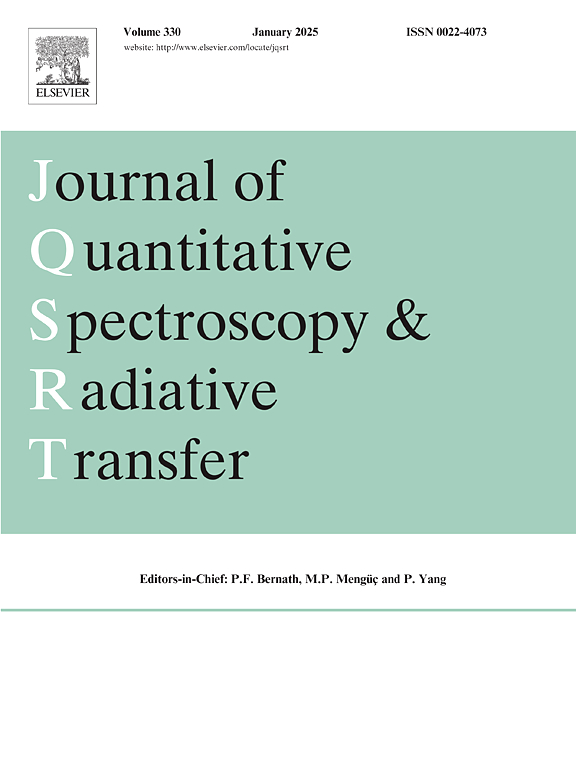Surface-integral-equation solution for solid particles with wavelength-scale surface roughness
IF 2.3
3区 物理与天体物理
Q2 OPTICS
Journal of Quantitative Spectroscopy & Radiative Transfer
Pub Date : 2025-04-12
DOI:10.1016/j.jqsrt.2025.109467
引用次数: 0
Abstract
A Surface Integral Equation (SIE) method has been implemented to analyze light scattering by arbitrarily shaped solid dielectric particles. Specifically, the Poggio–Miller–Chang–Harrington–Wu–Tsai formulation is discretized using the Galerkin method, employing Rao–Wilton–Glisson basis functions. The numerical solution is further accelerated through the application of the high-frequency Multilevel Fast Multipole Algorithm (MLFMA). This MLFMA-accelerated SIE solution demonstrates efficiency for homogeneous particles with moderately rough surfaces, even in the absence of advanced preconditioning techniques and broadband MLFMA. Notably, as the number of unknowns scales with the surface area, the SIE solution offers a distinct advantage over traditional volumetric methods, such as the discrete-dipole approximation and finite-element methods, where the number of unknowns scales with the volume of the scatterer. The SIE method is employed to investigate light scattering by homogeneous particles with rough surfaces, and the results are compared to the geometric optics approximation. It is demonstrated that the geometric optics approximation yields poor accuracy for particles with self-affine surface roughness.
具有波长尺度表面粗糙度的固体颗粒的表面积分方程解决方案
采用表面积分方程(SIE)方法分析了任意形状固体介电粒子的光散射。具体而言,Poggio-Miller-Chang-Harrington-Wu-Tsai公式采用Galerkin方法,采用Rao-Wilton-Glisson基函数进行离散化。通过应用高频多电平快速多极子算法(MLFMA),进一步加快了数值解的速度。即使在没有先进的预处理技术和宽带MLFMA的情况下,这种加速MLFMA的SIE解决方案也证明了对具有中等粗糙表面的均匀颗粒的效率。值得注意的是,由于未知的数量与表面积有关,SIE解决方案比传统的体积方法具有明显的优势,例如离散偶极子近似和有限元方法,其中未知的数量与散射体的体积有关。采用SIE方法研究了具有粗糙表面的均匀颗粒的光散射,并将结果与几何光学近似进行了比较。结果表明,对于具有自仿射表面粗糙度的粒子,几何光学近似的精度较差。
本文章由计算机程序翻译,如有差异,请以英文原文为准。
求助全文
约1分钟内获得全文
求助全文
来源期刊
CiteScore
5.30
自引率
21.70%
发文量
273
审稿时长
58 days
期刊介绍:
Papers with the following subject areas are suitable for publication in the Journal of Quantitative Spectroscopy and Radiative Transfer:
- Theoretical and experimental aspects of the spectra of atoms, molecules, ions, and plasmas.
- Spectral lineshape studies including models and computational algorithms.
- Atmospheric spectroscopy.
- Theoretical and experimental aspects of light scattering.
- Application of light scattering in particle characterization and remote sensing.
- Application of light scattering in biological sciences and medicine.
- Radiative transfer in absorbing, emitting, and scattering media.
- Radiative transfer in stochastic media.

 求助内容:
求助内容: 应助结果提醒方式:
应助结果提醒方式:


